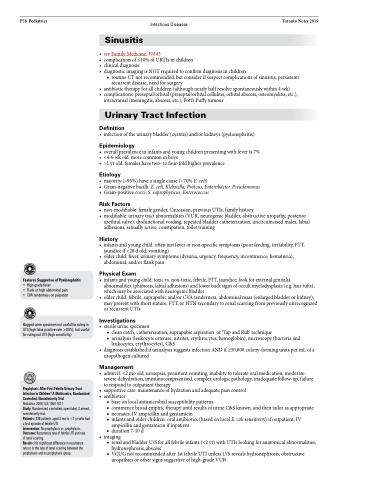Page 1092 - TNFlipTest
P. 1092
P58 Pediatrics
Infectious Diseases
Toronto Notes 2019
Features Suggestive of Pyelonephritis
• High-grade fever
• Flank or high abdominal pain • CVA tenderness on palpation
Sinusitis
• seeFamilyMedicine,FM43
• complicationof≤10%ofURTIsinchildren
• clinicaldiagnosis
• diagnosticimagingisNOTrequiredtoconfirmdiagnosisinchildren
■ routine CT not recommended, but consider if suspect complications of sinusitis, persistent/ recurrent disease, need for surgery
• antibiotictherapyforallchildren(althoughnearlyhalfresolvespontaneouslywithin4wk)
• complications:preseptal/orbital(preseptal/orbitalcellulitis,orbitalabscess,osteomyelitis,etc.),
intracranial (meningitis, abscess, etc.), Pott’s Puffy tumour
Urinary Tract Infection
Definition
• infectionoftheurinarybladder(cystitis)and/orkidneys(pyelonephritis)
Epidemiology
• overallprevalenceininfantsandyoungchildrenpresentingwithfeveris7% • <4-6wkold:morecommoninboys
• >1yrold:femaleshavetwo-tofour-foldhigherprevalence
Etiology
• majority(>95%)haveasinglecause(~70%E.coli)
• Gram-negativebacilli:E.coli,Klebsiella,Proteus,Enterobacter,Pseudomonas • Gram-positivecocci:S.saprophyticus,Enterococcus
Risk Factors
• non-modifiable:femalegender,Caucasian,previousUTIs,familyhistory
• modifiable:urinarytractabnormalities(VUR,neurogenicbladder,obstructiveuropathy,posterior
urethral valve), dysfunctional voiding, repeated bladder catheterization, uncircumcised males, labial adhesions, sexually active, constipation, toilet training
History
• infantsandyoungchild:oftenjustfeverornon-specificsymptoms(poorfeeding,irritability,FTT, jaundice if <28 d old, vomiting)
• olderchild:fever,urinarysymptoms(dysuria,urgency,frequency,incontinence,hematuria), abdominal, and/or flank pain
Physical Exam
• infantsandyoungchild:toxicvs.non-toxic,febrile,FTT,jaundice;lookforexternalgenitalia abnormalities (phimosis, labial adhesions) and lower back signs of occult myelodysplasia (e.g. hair tufts), which may be associated with neurogenic bladder
• olderchild:febrile,suprapubicand/orCVAtenderness,abdominalmass(enlargedbladderorkidney); may present with short stature, FTT, or HTN secondary to renal scarring from previously unrecognized or recurrent UTIs
Investigations
• sterileurinespecimen
■ clean catch, catheterization, suprapubic aspiration or ‘Tap and Rub’ technique
■ urinalysis (leukocyte esterase, nitrites, erythrocytes, hemoglobin), microscopy (bacteria and
leukocytes, erythrocytes), C&S
• diagnosisestablishedifurinalysissuggestsinfectionANDif≥50,000colony-formingunitspermLofa
uropathogen cultured
Management
• admitif:<2moold,urosepsis,persistentvomiting,inabilitytotolerateoralmedication,moderate- severe dehydration, immunocompromised, complex urologic pathology, inadequate follow-up, failure
Bagged urine specimen not useful for ruling in UTI (high false positive rate >85%), but useful for ruling out UTI (high sensitivity)
Prophylaxis After First Febrile Urinary Tract Infection in Children? A Multicentre, Randomized Controlled, Noninferiority Trial
Pediatrics 2008;122:1064-1071
Study: Randomized, controlled, open-label, 2 armed, noninferiority trial.
Patients: 338 patients aged 2 mo to <7 yr who had a first episode of febrile UTI.
Intervention: No prophylaxis vs. prophylaxis. Outcome: Recurrence rate of febrile UTI and rate
of renal scarring.
Results: No significant difference in recurrence
rate or in the rate of renal scarring between the prophylaxis and no prophylaxis group.
• •
•
to respond to outpatient therapy supportivecare:maintenanceofhydrationandadequatepaincontrol antibiotics
■ base on local antimicrobial susceptibility patterns
■ commence broad empiric therapy until results of urine C&S known, and then tailor as appropriate ■ neonates: IV ampicillin and gentamicin
■ infants and older children: oral antibiotics (based on local E. coli sensitivity) if outpatient; IV
ampicillin and gentamicin if inpatient ■ duration 7-10 d
imaging
■ renal and bladder U/S for all febrile infants (<2 yr) with UTIs looking for anatomical abnormalities,
hydronephrosis, abscess
■ VCUG not recommended after 1st febrile UTI unless U/S reveals hydronephrosis, obstructive
uropathies or other signs suggestive of high-grade VUR


